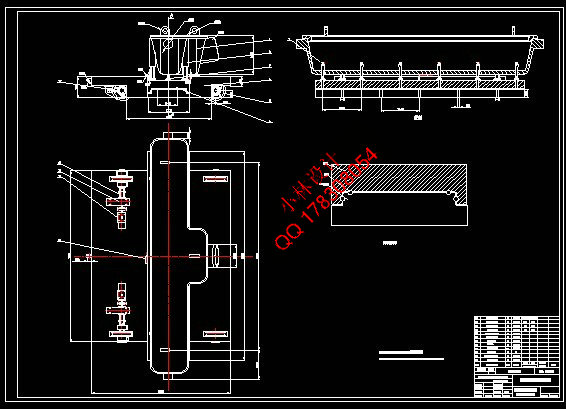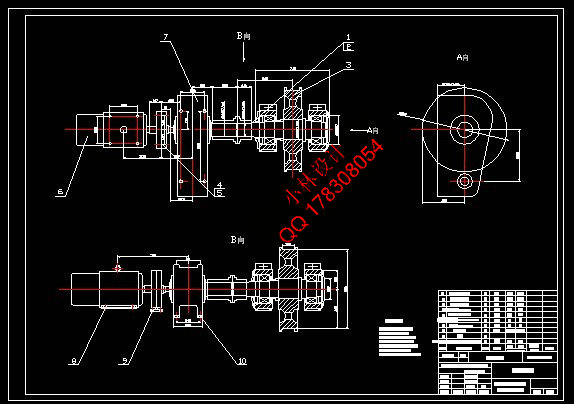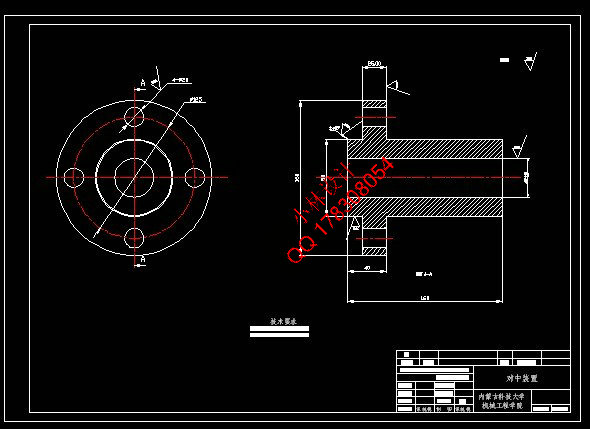|
设计简介 |
设计描述:
文档包括:
word说明书一份,共50页,约17000字
CAD版本图纸,共6张
中间罐小车设计
摘要
中间罐小车是在浇铸平台上起到放置和运送中间罐的作用。在浇铸前,小车载着烘烤好的中间罐开至结晶器上方,使中间罐水口对准结晶器中心或宽度方向的对称位置(当结晶器需要两个以上水口同时铸钢时)。浇铸完毕或发生事故不能继续浇铸时,它载着中间罐迅速离开浇铸位置。
中间罐车的设计与一般车辆的设计相比,相同之处在于必须有坚固的车架及可靠的运行机构和必要的辅助装置,不同之处在于应该满足连铸工艺的技术要求和操作要求,适应高温工作等特定条件。
本设计主要参考了包钢集团公司方坯连铸连轧厂的中间罐车,对中间罐车完成不同功能的几个重要机构进行了设计,主要包括:车架,行走机构,横向微调机构以及辅助装置的设计。车架的设计主要根据车间的布置和中间罐车的承载能力,对车架的材料选择并对车架的形式及长,宽,高进行设计。行走机构的设计主要根据中间罐车的承载能力,运行特点和车轮材料的选择,电动机和车轮的设计等。横向微调机构除了对液压装置的选取外,还设计了横梁形式和支承方式。辅助装置主要根据以上的设计和实际情况,对某些机构进一步补充和优化,具体见装配图。
关键词: 门型 两侧驱动 液压驱动
The design of the tundish car
Abstract
The tundish car is used for laying and transporting tundish on the casting platform. Before casting, the tundish car carries the well-baked tundish to the top of the mold, and makes the tundish’s outlet align the center or the symmetrical position of the width of the mold(When the mold needs two or more outlet to cast at the same time). When the casting finishes or an accident occurs while it can not continue to cast, it quickly leaves the casting position carrying the tundish.
Compared with the design of the design of the common vehicles, the design of the tundish car also needs solid rack reliable operation institutions and necessary assistive devices, but the differences lie that the tundish car should meet the technical and operational requirements of the continuous casting process and adapt to specific conditions such as high-temperature working environment.
The design of the main reference to the Baotou Steel Group Company billet continuous casting and rolling plant in the middle of tankers, tanker perform different functions on the middle of several important design institutions, including: frame, running gear, horizontal fine institutions and assistive devices. The design of the frame is mainly based on the layout of the workshop and the carrying capacity of the tundish, and then choose the material of it and design its form, length, width as well as height. The walking mechanism’s design is mainly based on the carrying capacity and operating characteristics of the tundish car, choose material of the wheel and electric motor, and then design the wheel. The design of the lifting mechanism is mainly the selection of the hydraulic devices as well as the calculation and design of the hydraulic system. While for the design of the horizontal adjustment mechanism, not only select the hydraulic devices, but also design the form of the beams and its way of bearing. The design of the assistive devices are mainly based on the above design and the actual situation, make further complement and optimization, please look them on the assembly drawings.
Keywords: door-type; bilateral driving; hydraulic driving
目 录
摘要 I
Abstract II
第一章 绪论 1
1.1 概要 1
1.1.1 中间罐车设计要求 1
1.1.2 中间罐车型式 1
1.2 中间罐车的结构及特征 3
1.2.1 车架 3
1.2.2 行走机构 3
1.2.3 提升机构 5
1.2.4 横向微调机构 5
1.2.5 称量机构 6
1.2.6 电缆卷筒 6
1.3 中间罐车的问题和改进 6
1.3.1 中间罐车常见的问题 6
1.3.2 中间罐车设计的改进 8
第二章 中间罐车的基本设计参数及方案 10
2.1 中间罐车的基本设计参数 10
2.2 设计方案及其选择 10
第三章 车架的设计 12
第四章 行走机构的设计计算 14
4.1 载荷和轮压的计算 14
4.1.1 载荷计算 14
4.1.2 轮压计算 14
4.2 车轮设计 16
4.2.1 车轮踏面疲劳载荷计算 16
4.2.2 车轮直径的选择 16
4.2.3 车轮转速计算 17
4.2.4 车轮校核 17
4.2.5 轨道的选择 17
4.3 运行阻力的计算 17
4.3.1 运行时摩擦阻力的计算 17
4.3.2 轨道弯曲变形引起的附加阻力计算 18
4.3.3 电缆拖链阻力计算 18
4.3.4 启动惯性阻力计算 19
4.3.5 运行阻力计算 19
4.4 行走机构传动功率计算 20
4.4.1 运行静功率计算 20
4.4.2 启动功率计算 20
4.5 电动机的选取及校核 20
4.5.1 电动机的选择 20
4.5.2 电动机的校核 21
4.6 传动机构的传动比计算 22
4.7 减速器、联轴器的选择 22
4.7.1 减速器的选择 22
4.7.2 联轴器的选择 23
第五章 提升机构的设计计算 24
5.1 液压缸的选择及校核 24
5.1.1 液压缸的选择 24
5.1.2 液压缸工作压力的选取 25
5.1.3 液压缸的校核 25
5.2 液压系统的计算 25
5.2.1 系统流量的计算 25
5.2.2 泵站电机功率的计算 26
5.3 液压系统的设计 26
5.3.1 液压系统的描述 26
5.3.2 液压泵站连锁控制 26
5.3.3 升降液压缸的控制 27
第六章 横向微调机构的设计计算 28
6.1 横向微调负载的计算 28
6.2 液压缸的选取 28
6.3 液压缸的工作压力的选择 28
6.4 液压缸的校核 29
6.5 中间罐支承梁的设计 29
第七章 中间罐小车三维建模设计 31
7.1 零部件三维建模设计 31
7.1.1 车轮 31
7.1.3 电动机 32
7.1.4 减速器 32
7.1.5 联轴器 33
7.1.6 闷盖 33
7.1.7 透盖 33
7.1.8 水口对中装置 34
7.1.9 支撑装置 34
7.1.10 制动器 35
7.1.11 中间罐 35
7.1.12 中间罐盖 36
7.1.13 轴承座 36
7.1.14 从动轮装配体 37
7.1.15 主动轮装配体 37
7.2 中间罐小车三维装配设计 37
7.2.1 中间罐小车三维装配 37
7.2.2 二维图纸应用 38
7.3 三维设计对于生产实际的意义 39
总结 40
致谢 41
参考文献 42
|










